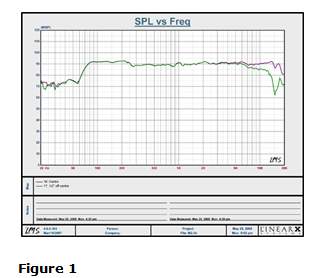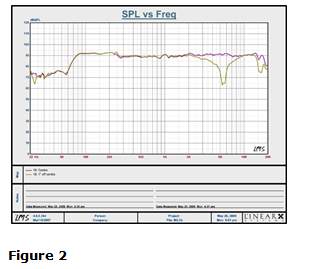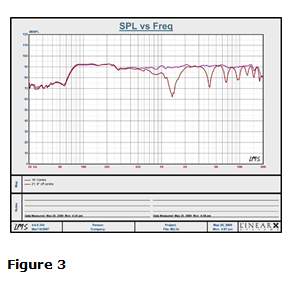From AXIOM:
Comb Filtering—Popular MisconceptionsPerhaps it seems odd to discuss the teeth of a comb in connection with loudspeaker sound reproduction or the propagation of real sound waves, but it is relevant.
Comb filtering is a catchy audio phrase that’s used in audio discussions on forums, in articles, and often in the context of critical comments about the specifics of a particular speaker design. The fact is that comb filtering is simply a measurement artifact and does not detract from the listening experience. The research shows that comb filtering is not detrimental to accurate loudspeaker sound reproduction; at worst, it’s irrelevant, at best it actually adds a pleasurable element of spaciousness to stereo and surround sound.
That said, you might ask if it’s a measurement artifact, and careful measurements are instrumental to the scientific approach to acoustics and loudspeaker design that Bryston espouses, then why don’t we hear comb filtering with music and speech? Let’s break it down.
A Microphone Is Not Two EarsIt must be pointed out that a measurement microphone—even a very expensive lab-calibrated model like the one Bryston uses (a B & K)—is like a single ear with no brain. As human beings, we hear with two ears and a brain, the latter being an incredibly sophisticated audio processing unit that is constantly comparing signals received from our two ears and sorting out not only directional cues and amplitude (loudness) differences but also ignoring or disregarding information that might be confusing or detrimental to our sound localization, spatial perception and tonal identification abilities.
What Is Comb Filtering? Simply stated, comb filtering is two signals arriving at the same location at different times. Because of the differences in the arrival times, the sound waves will have additions when they perfectly overlap and reinforce each other, and also have cancellations or nulls where they cancel each other out (the latter is called destructive interference). This occurs in virtually all speaker systems whose musical ranges overlap, where both drivers are reproducing the same sounds, as in stereo or surround sound, and because of multiple drivers with different physical locations used to cover the same frequency range.
To illustrate how a single measurement microphone “hears” or identifies comb filtering, we set up an interesting experiment in the anechoic chamber. Two quality bookshelf speakers were placed in the chamber 6 feet apart. The calibrated B & K microphone was placed 6.5 feet away and directly in the center in the sweet spot between the two speakers. A standard frequency sweep from 20 Hz to 20 kHz was played back over the two speakers and we recorded the test sweep with the measurement microphone. The purple curve in Figure 1 shows the frequency response with the microphone exactly centered in the sweet spot between the two loudspeakers.

Then we moved the measuring microphone ½-inch to the side, off center from the sweet spot, and recorded another frequency-response curve. The green curve in Figure 1 shows the first comb cancellation effect at 15 kHz.
Then we moved the microphone 1 inch off center and ran another curve. In Figure 2, the green curve shows the next comb filter cancellation at 5.5 kHz. In Figure 3, the measurement microphone was moved 8 inches off center from the sweet spot. The dark greenish curve shows the pronounced comb-filtering cancellations beginning just below 1.5 kHz and extending all the way up to 18 kHz. The dips in response resemble the downward teeth of a comb, hence the name “comb filtering”.


The cancellations (dips) are what the single measurement microphone “hears” and measures using a full-frequency test sweep when the signals from the two M2 speakers don’t perfectly overlap. This seems like an acoustic effect that may be potentially nasty in nature and should be avoided. These are pronounced cancellations, yet when we play music or speech over a pair of speakers, we don’t hear these comb filtering effects. Why is that?
How Does the Brain Deal With Comb Effects?The precedence effect (previously known as the Haas Effect) dictates that our brain and ears pick out the location of a sound source that reaches our ears in the first few milliseconds of a sound’s arrival. The first sound to arrive at the ears enables you to determine the direction of the source. After hearing an initial signal, the brain will suppress any later-arriving signals, up to about 30 milliseconds. These later-arriving signals that show up with steady-state pink noise (within the 30-millisecond window) do not disrupt the brain’s precise localization mechanism. What occurs is that you do not “hear” the contributions of the later-arriving sounds from the adjacent drivers that are responsible for the measurement artifact of comb filtering. Or rather, your brain hears and processes them but disregards them lest they confuse our directional acuity; in fact all they do in the listener is create a sense of added spaciousness. Numerous scientific researchers, including definitive experiments conducted by Dr. Floyd Toole and Dr. Sean Olive, have verified this. Even in a room having lots of reflections, our brains correctly determine the direction of sounds. (By the way, sounds arriving at our ears after a delay of more than 30 milliseconds are perceived as a second sound or echo.)
Critics of comb filtering who believe it to be a big issue in speaker design have the option of listening in mono to avoid the comb filtering. But we all much prefer listening to music and vocalists in stereo—it’s far more spacious and realistic--and the reason is that our brains and two ears simply ignore those cancelling signals that on paper show up with a test signal and a single microphone.
Enthusiasts who would like to read further about comb filtering and psycho-acoustics should explore Sound Reproduction: Loudspeakers and Rooms, by Floyd E. Toole, Focal Press. Available from Amazon.co
FURTHER THOUGHTS: - From Ian at Axiom:
I will start this answer to your “question” with a conclusion; you need not concern yourself with the measurement phenomenon known as comb filtering. Since we produce multi-driver systems here at Bryston we have put much research into understanding the impact of comb filtering on the real world listening environment.
There are huge benefits to using multiple drivers, especially in the area of being able to produce large dynamic range without distortion, so it is not something that should be casually thrown out of your design options. Certainly, on the surface, if you were to only look at the measurements taken by the microphone of comb filtering, without any further research, you would probably decide it is something that must be avoided. But this would be an over simplistic and very counter-productive way to actually design a great sounding loudspeaker. It would be akin to simply taking a bunch of measurements and then go about drawing theoretical conclusions based on those measurements without feeling the need to do any real world testing of your theories. This will result in some great marketing propaganda and some great discussion material in which to back up your theories; but it would not result in a great sounding loudspeaker. The proper approach is to go through the somewhat painstaking process of understanding each measurement and its effect on the final listening experience, paying careful attention to the thresholds of audibility and the interrelationship with other measurements that may hold a greater significance to the end listening performance.
So let’s take a look at comb filtering in this light. First off comb filtering can be measured any time two drive units are playing the same frequency and the microphone is not located exactly equidistant between them. For example, if we take a standard stereo pair of speakers located say 8 feet apart, any movement of the microphone off centre, even as small as ½ inch, will show the affects of comb filtering. In order to avoid comb filtering occurring in our listening environment not only would we have to restrict ourselves to loudspeakers that only used one driver per frequency allocation, which would have huge detrimental effects on the ability to achieve great dynamic range, but we would have to restrict ourselves to only having one speaker in the room, in other words return to listening in mono through one speaker. Given the obvious enormous downside to doing this perhaps first we should review the real world results of comb filtering in our listening environment before rushing off and getting rid of all our speakers save one.
One of the more revealing tests we performed in our lab was to set up a double blind listening test where we had three identical speakers and compared only playing the single speaker in the middle against playing the two on the outside simultaneously. We conducted this test in two separate sessions; one with the three speakers placed side by side, which gave us about a 15” separation between the drivers playing simultaneously, and one with the two outer speakers placed one meter to each side of the centre speaker. The amplitude response was preset so the two speakers had the same output as the single speaker and only a mono source was used. Not to wander off into a completely different subject, but it is worth at least noting that these sorts of tests must be done double blind. Any attempt to do them sighted or with the participants knowing what is on test will result in the participants who understand the effects of comb filtering on the measurements becoming biased in their judgment. This holds true for virtually all tests in audio and we have proved this over and over.
The results of that test were a clear winner for the widely separated pair and a slight nod for the closely positioned pair; the single speaker lost in both tests. The moral of the story here is to be careful when interpreting your measurement results and falling into the trap of thinking a microphone is giving you the exact results that will be perceived by two ears and a brain. In the case of comb filtering such a simplistic approach to loudspeaker design would cause the designer to throw out all the benefits of multi-driver systems to gain nothing. Forget about having to choose between taking a small degradation in one area in order to achieve a much larger benefit in another, which would also be a valid design decision; in the case of avoiding comb filtering you have to give up a very large benefit to gain absolutely nothing.
I think one of the most eloquent comments ever made regarding the dangers of taking microphone measurements for granted was by Dr. Floyd Toole in one of his papers written back when we were doing our research at the NRC; “A measurement microphone performs a simple transduction of the pressure summation at the diaphragm location, without regard for the direction or timing of the incident sounds. Two ears and a brain, however, are rather more elaborate in their processing”.